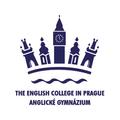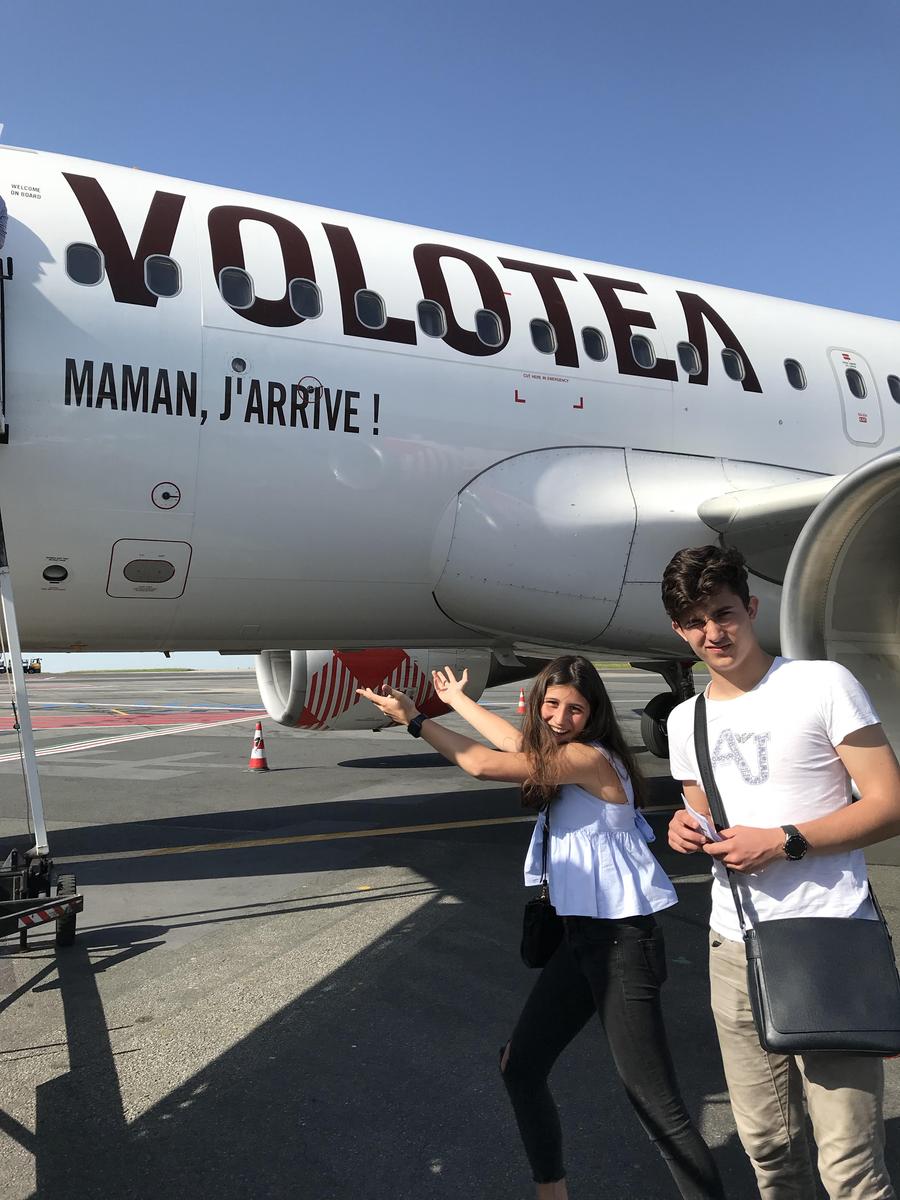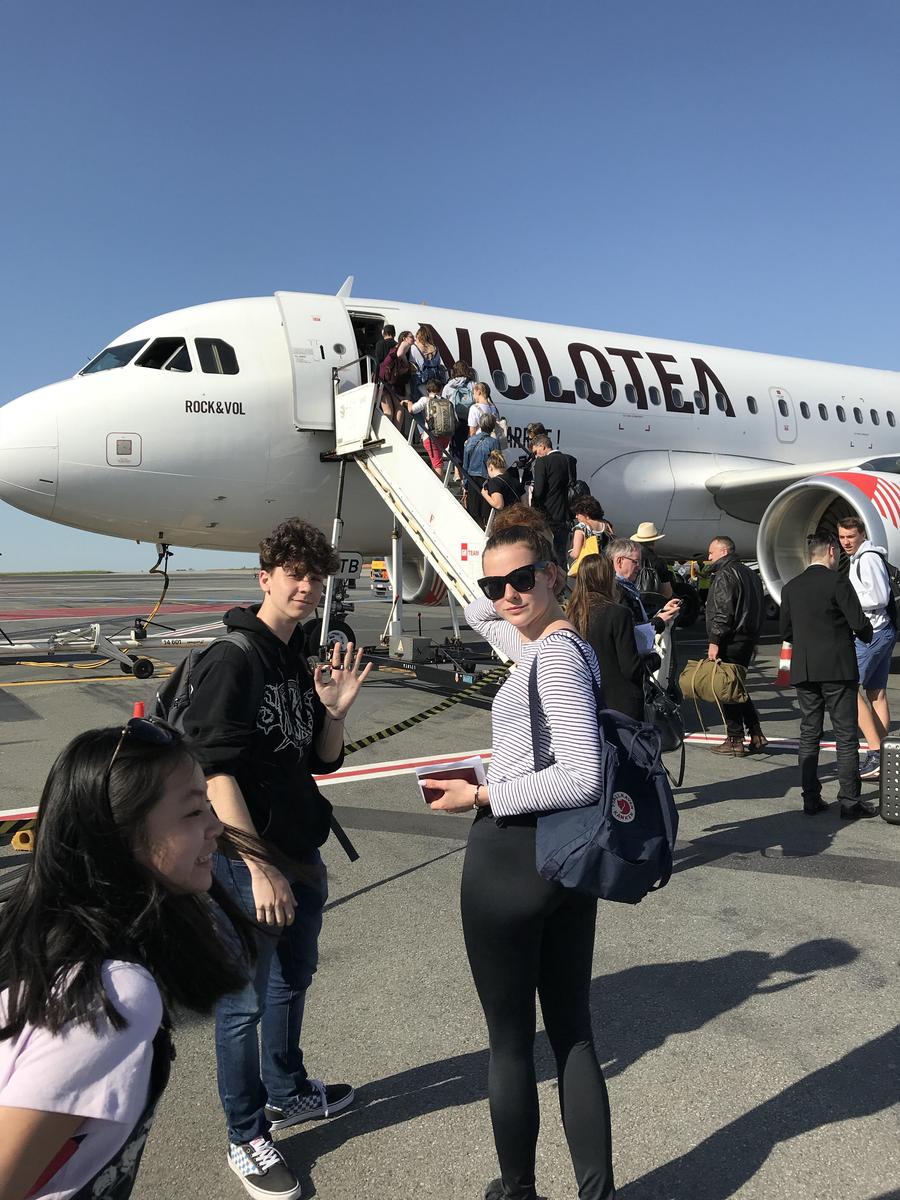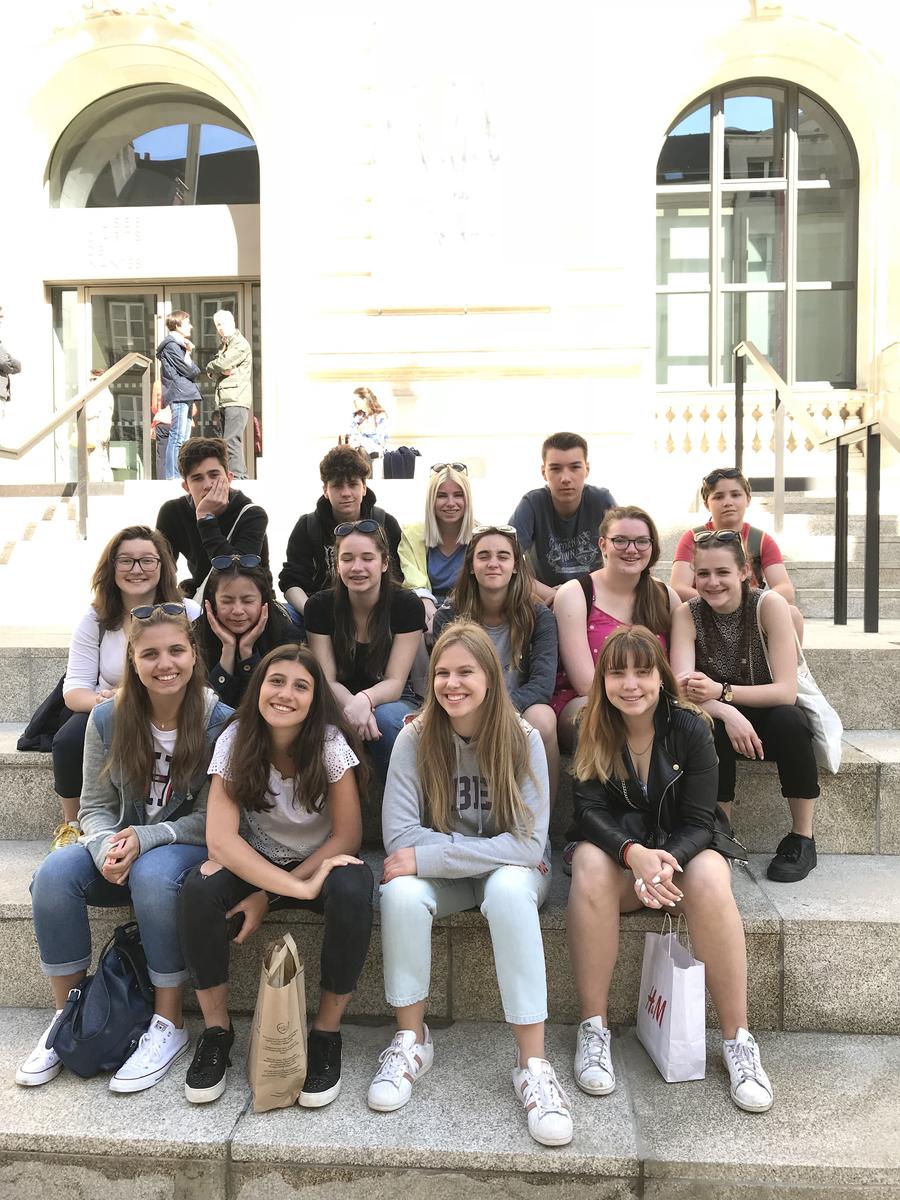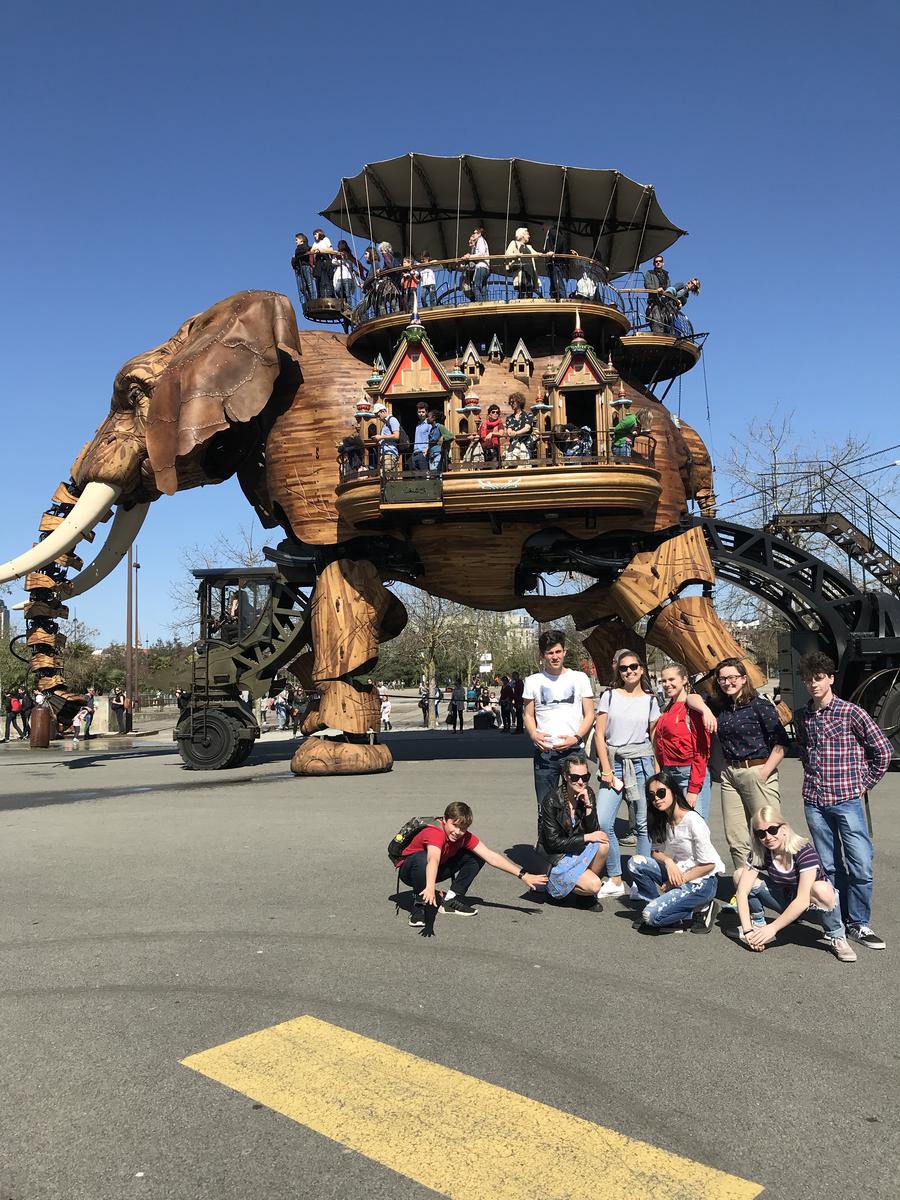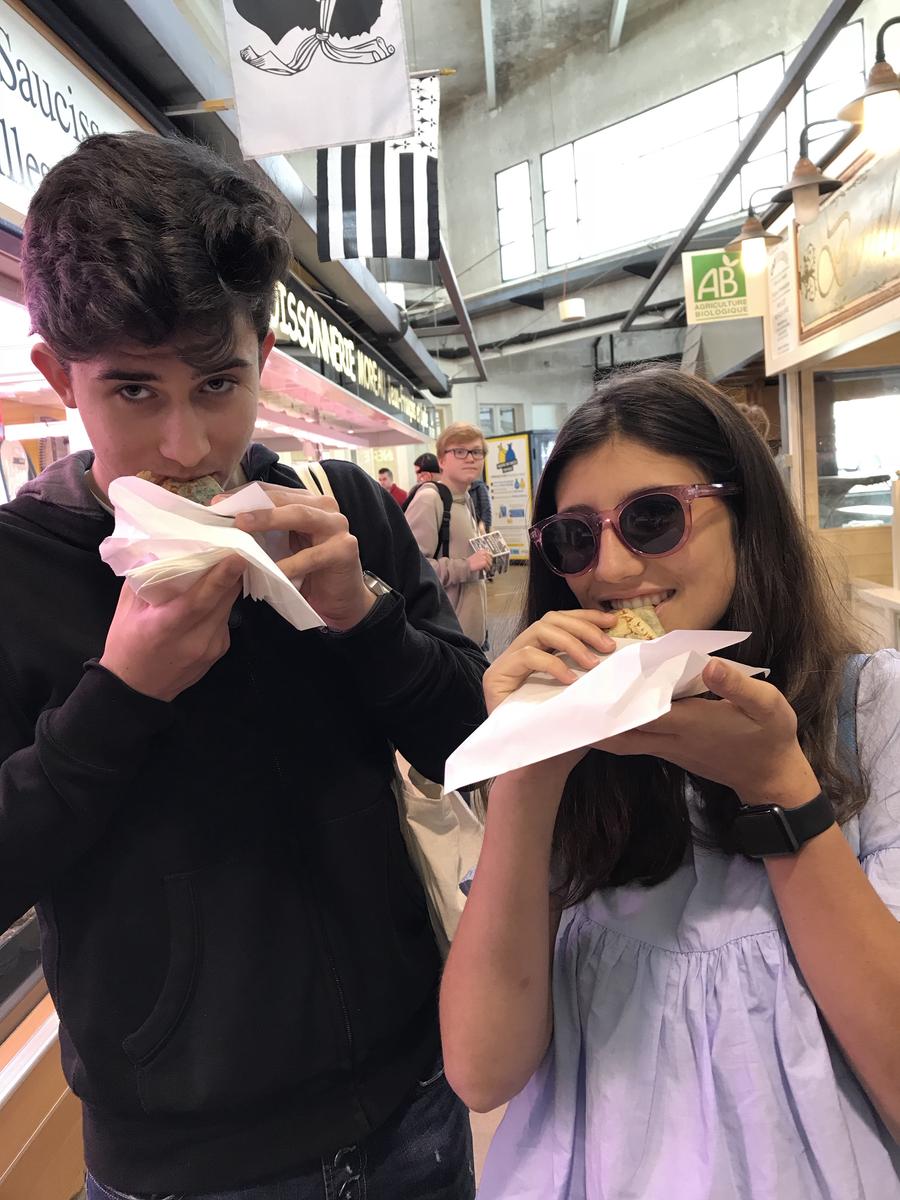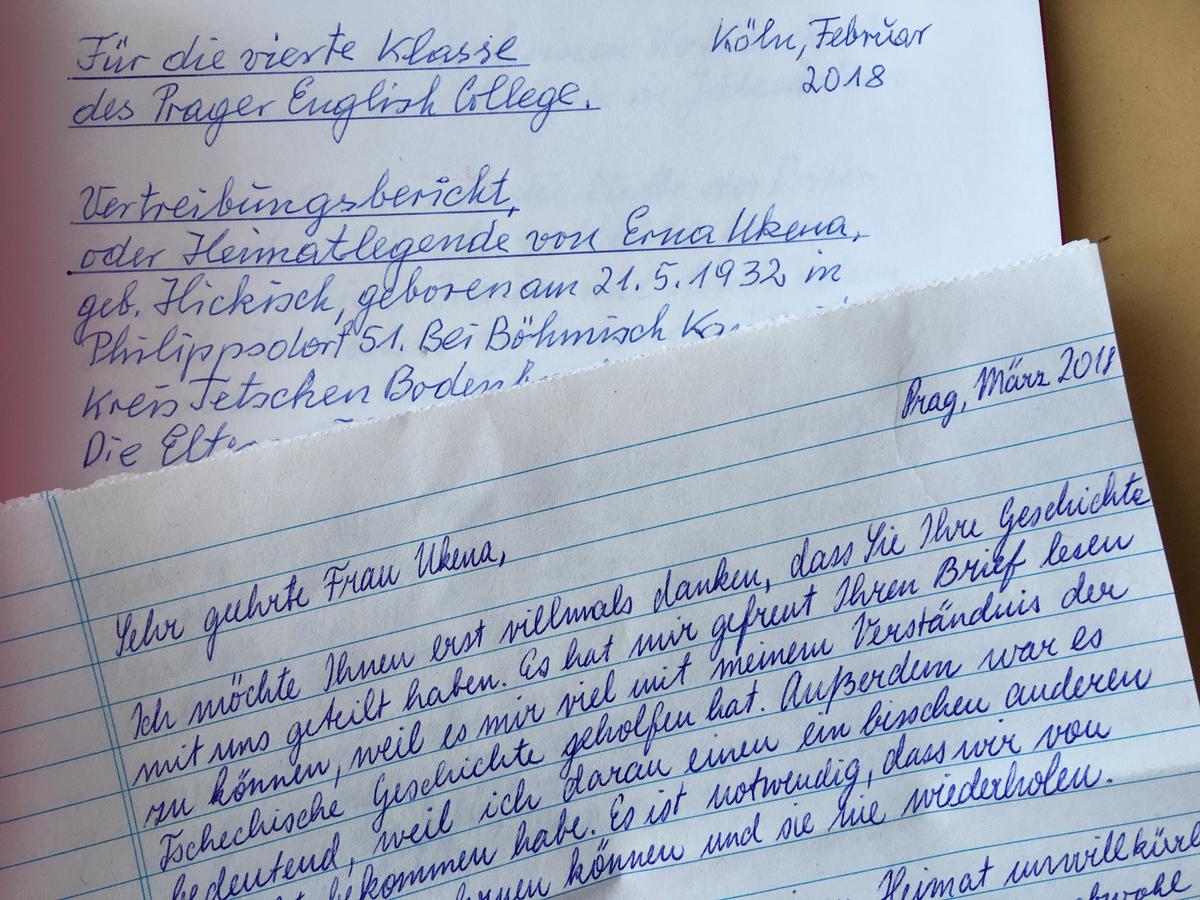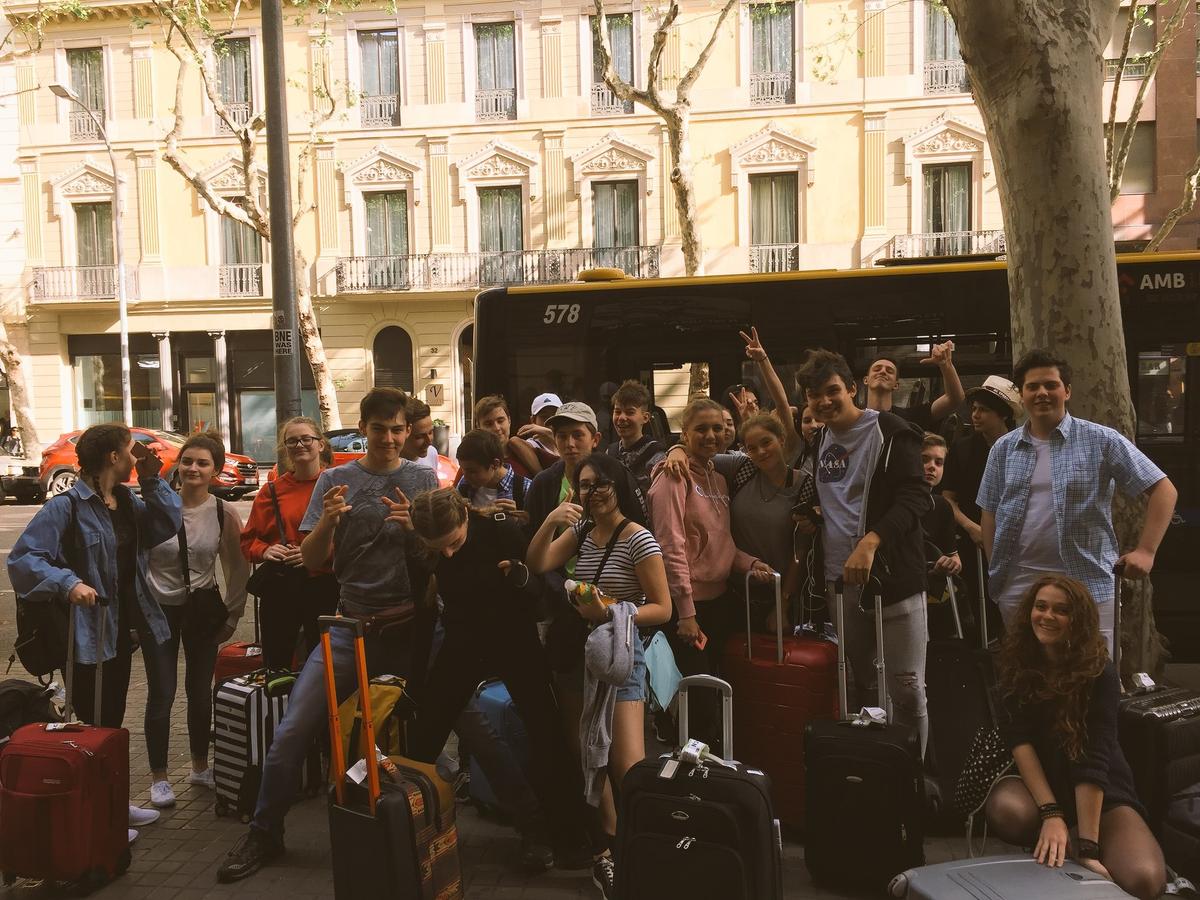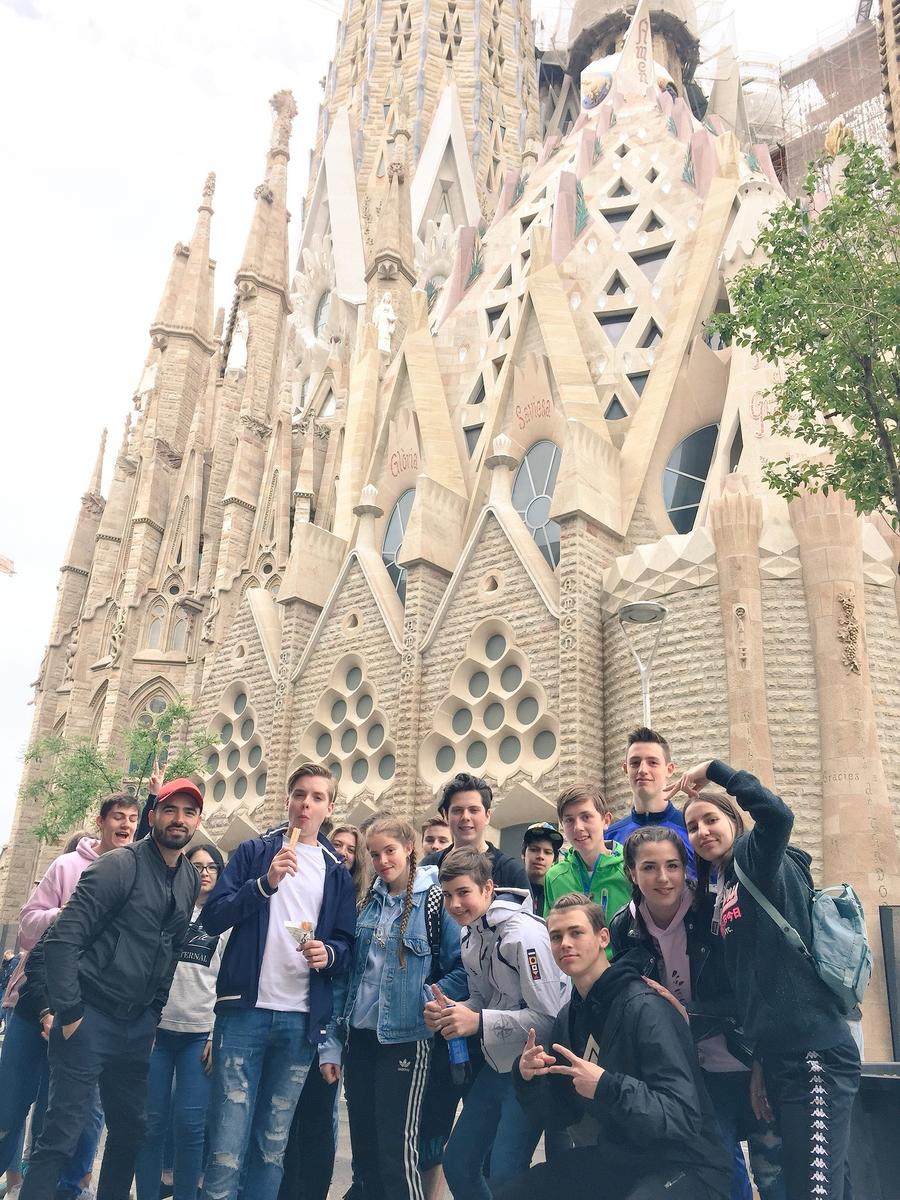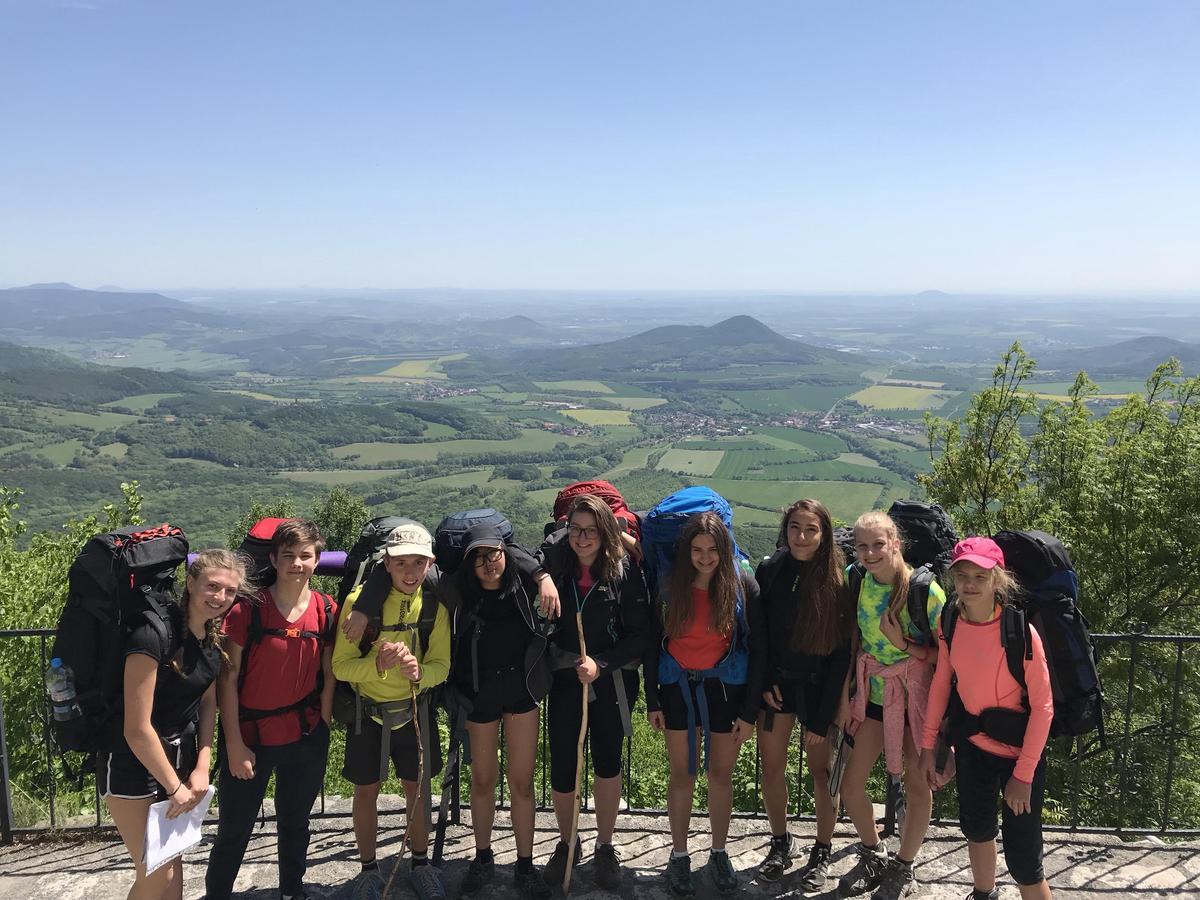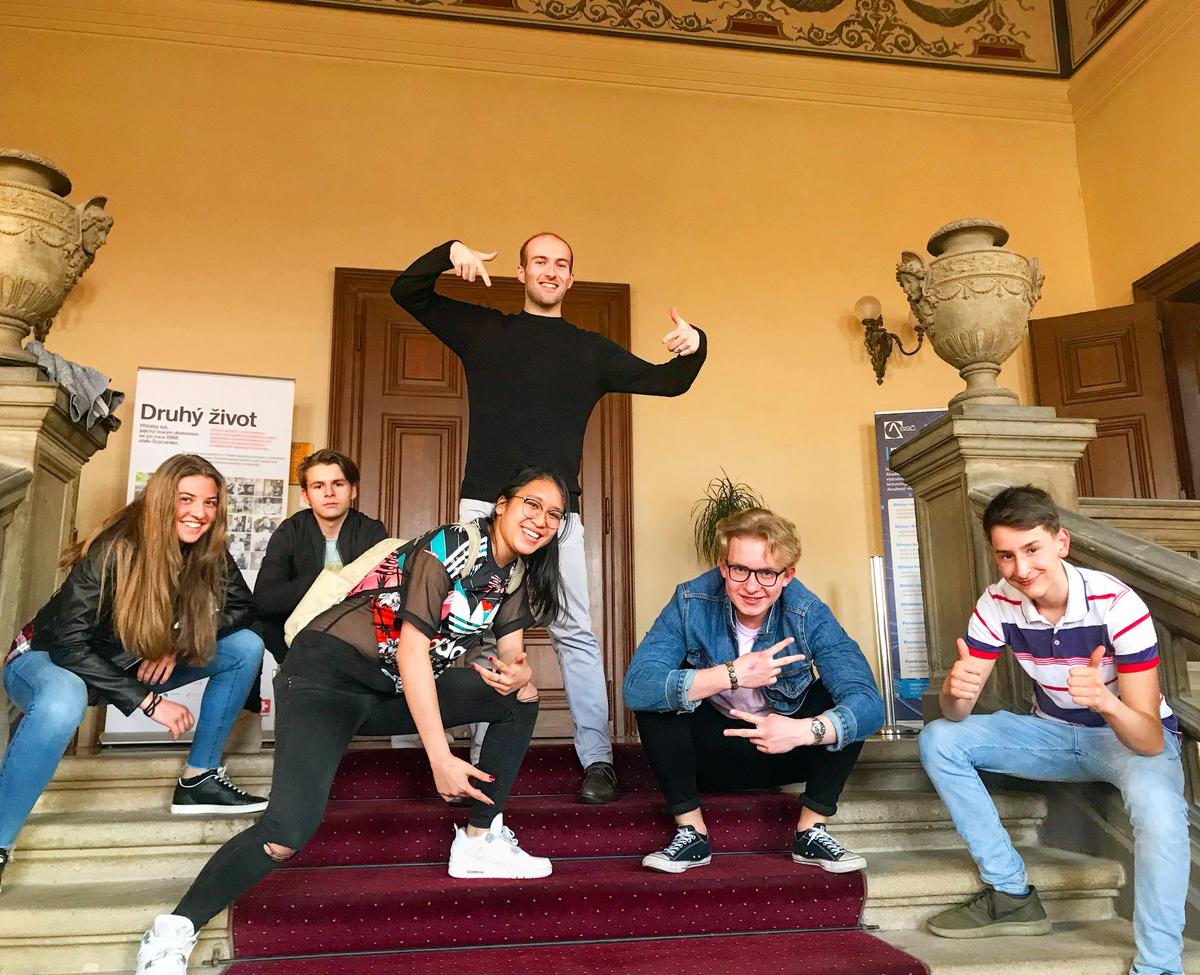Trips /Výlety
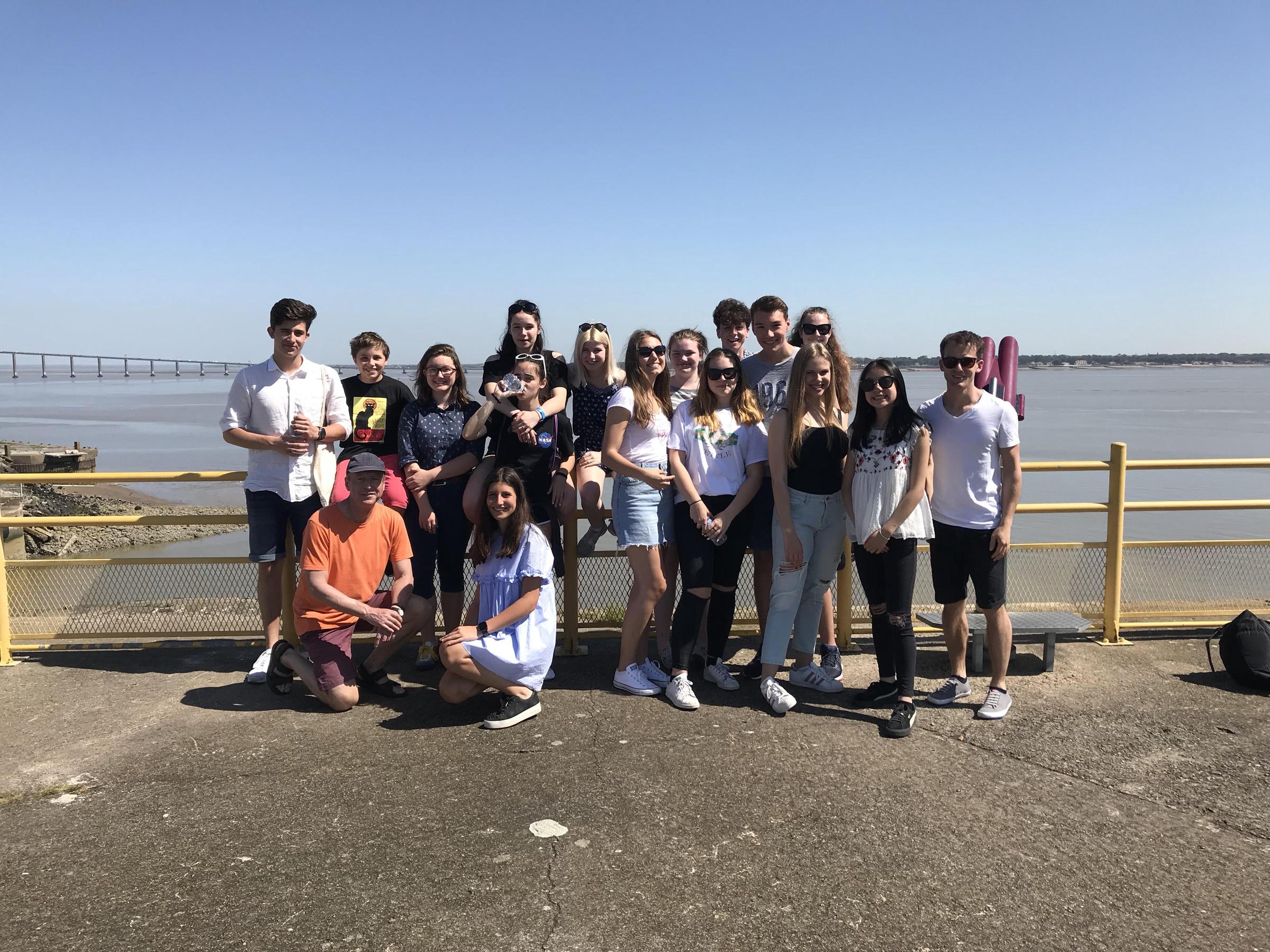
French Exchange/
Výměnný pobyt s Francií
ECP students from Years 2 and 3 enjoyed the wonderful weather in Nantes on their French Exchange visit! Merci Lycees Notre Dame for an excellent week in Nantes for the French Exchange.
The French Exchange is an annual exchange of students between our school and a French school in Nantes. First the French students came to visit Prague in December, where they discovered the history and culture of our city, while staying with our students in their homes. Then we visited Nantes in April. We spent the first day in Paris where we got to see some famous monuments like the arc de triomphe and the Louvre. Then we took the TGV to Nantes where we met our partners and were welcomed in their homes. Personally, I feel that the French Exchange is a great way to force yourself into practising your French skills in not only speaking, but also in listening, while sitting at the dinner table, or reading skills when trying to get somewhere in the town. It was a great experience!
Viktor Bednář, Y3 student
Výměnný program French Exchange je každoroční výměnný studentů mezi naším gymnáziem a francouzskou školou v Nantes. Francouzští studenti nás nejprve v prosinci přijeli navštívit do Prahy, aby objevili historii a kulturu našeho města a bydleli s našimi studenty v jejich domovech. Poté jsme v dubnu my navštívili Nantes. První den jsme strávili v Paříži, kde jsme se mohli seznámit s některými slavnými památkami, jako je Vítězný oblouk či Louvre. Následně jsme jeli vlakem TGV do Nantes, kde jsme se setkali s našimi studentské partnery, kteří nás přivítali ve svých domovech. Osobně se domnívám, že výměnný pobyt ve Francii je skvělý způsob, jak se přinutit k procvičování francouzského jazyka, a to nejen při mluvení, ale také při poslechu, například během večeře, nebo při čtení, například když se snažíte ve městě někam dostat. Byla to skvělá zkušenost!
Viktor Bednář, student 3. ročníku
Y4 Sudetenland Trip Follow-Up Correspondence /Výlet 4. ročníku do Sudet má své pokračování
Y4 students of German participate in a letter exchange with the members of the German community expelled from Sudetenland in 1945 from the Česká Kamenice area. This is how they learn about their fascinating life stories
Studenti němčiny ze 4. ročníku si dospisují s odsunutými Němci z okolí České Kamenice, kteří museli odejít z Československa po roce 1945. Studenti tak získávají pozoruhodná svědectví o životech odsunutých Němců.
Trip to Karlštejn/Výlet na Karlštejn
Year 3’s Duke of Edinburgh’s International Award practice hike from Beroun to Karlštejn.
Studenti 3. ročníku vyrazili na výlet z Berouna na Karlštejn v rámci programu Mezinárodní ceny vévody z Edinburghu.
Barcelona trip/Výlet do Barcelony
Y3 Spanish class arriving to Barcelona/Studenti 3. ročníku v Barceloně
Y3 Spanish class at Sagrada Familia/Studenti 3. ročníku španělštiny u chrámu Sagrada Família
Berlin/Berlín
ECP's Y3 students of German were enjoying hands-on-graffiti during their recent trip to Berlin.
Studenti německého jazyka (3. ročník) vytvářeli během nedávného výletu do Berlína hands-on-graffiti.
International Duke of Edinburgh's Award/
Mezinárodní cena vévody z Edinburghu
ECP students in years 2&3 completed their Bronze qualifying expedition in České Středohoří.
Studenti Anglického gymnázia ve 2. a 3. ročníku na své bronzové kvalifikační expedici v Českém středohoří.
Exhibition Second Life/Výstava Druhý život
Students of the English College Debating Society were invited by the Swiss Embassy and the Learned Society of the Czech Republic to attend a discussion “Challenges of integration in a new country: Traditions and the current situation in Switzerland and in the Czech Republic”, with many esteemed guests, including the Czech Minister of the Interior and the Swiss Secretary of State for Migration and it was moderated by Tomáš Lindner - editor of Respekt magazine.
The keynote speakers on the panel were asked to put forward their views on migration and immigration from their country’s perspective, with a follow-up question and answer session. The students who participate in the Debating Society are continually striving to improve on their debating, public discussion and speaking techniques, so this was a fantastic opportunity for them to see professionals in a live event. The most heated discussions and debates came from the audience, subsequent to the keynote speakers conveying their viewpoints, with regard to the more recent re-election of President Zeman and his views on immigration; the ideals of the unsuccessful candidate Jiří Drahoš; the prejudice against minority communities, such as the Roma people; the contentious issue of Czech-Russian relations and a distrust that many Czech nationals maintain following the invasion of 1968.
The accompanying book, A Second Life, is published on the occasion of an eponymous exhibition organised by the Swiss Embassy in the Czech Republic to mark the 50th anniversary of 21 August 1968 - The Warsaw Pact Invasion of Czechoslovakia. The book consists of interviews with 25 Czechs and Slovaks who found a new home in Switzerland after 1968. The exhibition at Galerie kritiků – Palác Adria (4.4.18 - 22.4.18) focused on these questions: how do the Czech and Slovak migrants perceive their identity today? In what ways did their lives develop? What relationship do they have with their native country? The photographic portraits in the exhibition, of these Czech and Slovak individuals, are the work of Iren Stehli.
Iren Stehli was born in 1953 in Zurich, where she grew up in a bilingual environment - her mother was Czech, her father Swiss. In 1972, she left for Prague, where she briefly attended courses in Slavic Studies at Charles University before deciding to focus on photography and being accepted at FAMU. After completing her studies in 1982, she lost her student visa status and returned to Zurich. In 1993-2001 she helped set up the Czech branch of the Pro Helvetia cultural foundation in Prague. Since then, she has worked as a freelance photographer based in both Prague and Zurich.
In her work, she has focused on long-term photographic projects, such as Dancing Lessons (1974-1977), Libuna (1974-2009), and Still-Lifes (1975-2002). Several of her series documented life in Czechoslovakia during Normalisation and after the Velvet Revolution - Prague Walls and Streets (1976-1990), Prague Shop Windows (1978-today). In 1996, Torst Publishers published a book of her photographs from the series Prague Shop Windows 1978-1996. In 2004, Zurich-based publisher Scalo published the Libuna - A Gypsy's Life in Prague. A monograph on Iren Stehli was published by Fototorst in 2006. Both the discussion and the accompanying text provide an interesting insight into the second life that had to be adopted, by many Czechs and Slovaks, who moved to Switzerland in 1968. We should also keep in mind that many more people migrated to Switzerland 50 years ago, and that thousands of people must leave their home countries for many reasons, including persecution and war, but ultimately through no fault of their own. We hope that as many people as possible visited the exhibition at Galerie kritiků – Palác Adria as it raised awareness about immigration and the positive impacts it has on a country, rather than the negatives that can be highlighted in the media. The exhibition also acted as a reminder of how the actions of humans, as seen in the Warsaw Pact Invasion of Czechoslovakia, should not be repeated.
Euan Gray, Senior Tutor of Ignis, Teacher of Biology
Studenti Anglického gymnázia byli pozváni Švýcarským velvyslanectvím a Učenou společností České republiky, aby se zúčastnili diskuse "Výzvy integrace v nové zemi: Tradice a současná situace ve Švýcarsku a v České republice", s mnoha váženými hosty, včetně českého Ministra vnitra a Švýcarského ministra pro migraci, akci moderoval Tomáš Lindner - redaktor časopisu Respekt.
Hlavní přednášející na panelu byli požádáni, aby předložili své názory na migraci a přistěhovalectví z perspektivy své země s následnými otázkami. Studenti, kteří se účastnili Debatního klubu, neustále usilují o zdokonalení svých debat, veřejných diskuzí a technik mluvení, takže to byla fantastická příležitost vidět odborníky. Nejzajímavější diskuse byla od publika poté, co hlavní přednášející vyslovili své názory, s ohledem na novější znovuzvolení prezidenta Zemana a jeho názory na přistěhovalectví; ideály neúspěšného kandidáta Jiřího Drahoše; předsudky vůči menšinovým komunitám, jako jsou Romové; sporná otázka česko-ruských vztahů a nedůvěra, kterou si řada českých občanů udržuje po invazi v roce 1968.
Publikace Druhý život doprovází stejnojmennou výstavu, kterou uspořádalo švýcarské velvyslanectví v České republice u příležitosti padesátého výročí 21. srpna 1968, a přináší rozhovory s pětadvaceti Čechy a Slováky, jejichž domovem se po roce 1968 stalo Švýcarsko.
Iren Stehli se narodila v Curychu v roce 1953. Vyrůstala v dvojjazyčném prostředí, její matka byla Češka a otec Švýcar. V roce 1972 odjela do Prahy, kde se po krátkém studiu slavistiky na Univerzitě Karlově v Praze rozhodla věnovat fotografii a byla přijata na FAMU. Po ukončení studia v roce 1982 jí zároveň skončilo povolení k pobytu v Československu a vrátila se zpět do Curychu. V letech 1993-2001 v Praze řídila českou pobočku švýcarské kulturní nadace Pro Helvetia. Od té doby pracuje jako fotografka na volné noze, žije střídavě v Praze a v Curychu.
Ve své tvorbě se věnuje dlouhodobým fotografickým projektům (například Taneční, 1974-1977; Libuna, 1974-2009; Zátiší, 1975-2002 atd.), v několika svých cyklech fotografií zdokumentovala život v Československu v období normalizace i po sametové revoluci (Pražské zdi a ulice, 1976-1990; Pražské výlohy, 1978-dodnes). Fotografie z cyklu Pražské výlohy 1978-1996 byly vydány knižně v nakladatelství Torst (1996). V roce 2004 vydalo curyšské nakladatelství Scalo reprezentativní publikaci Libuna - A Gypsy's Life in Prague. Monografie Iren Stehli vyšla v edici Fototorst v roce 2006. Diskuse i doprovodný text přinášejí zajímavý pohled na druhý život, který muselo přijmout mnoho Čechů a Slováků, kteří se přestěhovali do Švýcarska v roce 1968. Měli bychom také mít na paměti, že do Švýcarska emigrovalo mnoho lidí před více než 50ti lety a že tisíce lidí muselo opustit své země původu z mnoha důvodů, včetně pronásledování a války, bez vlastního zavinění. Doufáme, že co nejvíce lidí navštíví výstavu Galerie kritiků - Palác Adria, protože zvyšuje povědomí o přistěhovalectví a pozitivní dopady, které má na zemi, spíše než negativa, které lze v médiích zvýraznit. Výstava také připomněla, proč by se neměla opakovat události, jako byla Varšavská smlouva o invazi Československa.
Euan Gray, učitel biologie
